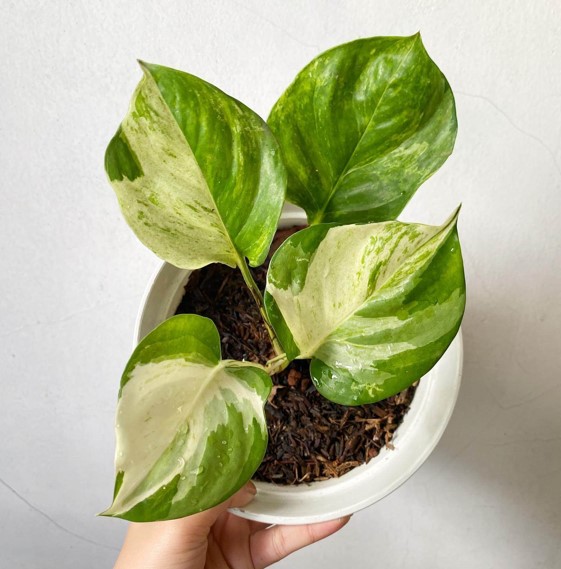When I first started my indoor gardening journey, the pothos plant was one of those that captured my heart. As a new indoor gardener, I was really drawn to their easy-going nature.
I started out by buying a small pothos plant from my local garden center and placing it on my kitchen windowsill. Within days, the little plant had started to grow new leaves and vines. I was hooked.
Since then, I’ve gradually expanded my indoor garden to include a variety of different plants, but the pothos always holds a special place in my heart. They’re the perfect plant for beginners and experts alike.
There are many varieties of pothos, and they all have their own unique appearance.
In this blog post, I’ll share 17 different types of pothos and how to tell them apart. We’ll also provide care tips so you can keep your pothos healthy and thriving. Read on to learn more!
In this post
- Golden Pothos (Epipremnum aureum)
- Jade Pothos (Epipremnum aureum ‘Jade’)
- Marble Queen Pothos (Epipremnum aureum ‘Marble Queen’)
- Neon Pothos
- N’Joy Pothos
- Jessenia Pothos
- Manjula Pothos (PP27,117)
- Pearls and Jade® Pothos (PP21,217)
- Cebu Blue Pothos
- Emerald Pothos
- Global Green Pothos (PP33,530)
- Hawaiian Pothos
- Jade Satin Pothos
- Treubii Moonlight Pothos
- Snow Queen Pothos
- Variegated Neon Pothos
- Glacier Pothos
Golden Pothos (Epipremnum aureum)
Golden pothos is the most common type of pothos that you can easily find in your local garden center, online shops, even your neighbor might have it. In fact, it is the original pothos.
Golden pothos plant is known for its distinctively bright green leaves with a yellowish-golden splashes.
When growing outdoors, this plant can grow a wide leaves! I have one that has reach more than 10 inches wide.
Jade Pothos (Epipremnum aureum ‘Jade’)
Jade Pothos is a naturally occurring variation of golden pothos. Both share many similarities including leaf shape, growth size and maintenance requirements.
The only difference between them is that jade pothos has dark green leaves without any variegations; this makes it more low light tolerant than golden pothos.
Marble Queen Pothos (Epipremnum aureum ‘Marble Queen’)
Marble queen pothos is a cultivar of golden pothos with beautiful creamy-white and green variegated leaves.
The leaf shape and size of this plant is usually similar to the golden pothos, but it has a creamy-white splashes pattern that looks like marble.
The easiest thing to notice this plant is sometimes you can spot wide green spots on some of its leaves. This inconsistent pattern may happen due low chlorophyll levels.
As this plant is highly variegated, it is important to put this plant in a place where it gets bright sunlight. If you have east-facing windows, it’s best to put it near there.
Neon Pothos
Neon pothos is a cultivar of pothos that has bright, vibrant limegreen or chartreuse color with no variegation.
The young leaves of neon pothos are neon-yellow that looks shiny when contacted with light, but as they grow older, it becomes slightly darker.
Neon pothos plants need a certain amount of light to grow healthy and vivid leaves.
The best temperature for this plant is between 60-80 degrees Fahrenheit, but they also like it when there’s some shade in their environment too.
It’s important that you find the right balance between light and shade. If it gets too much sun, the leaves will become pale in color. On the other hand, if it doesn’t get enough sunlight, the leaves will become darker.
N’Joy Pothos
N’Joy pothos is a cultivar of marble queen pothos that has smaller leaves than the traditional pothos. I also notice that the distance between the nodes is smaller too.
This plant has white variegation against dark green leaves that typically sticking to the outside edges of its foliage.
N’Joy pothos and pearls and jade pothos are often mistaken for one another, but the key difference is that N’Joy pothos has solid patches of white and green, where pearls and jade pothos has speckles.
Jessenia Pothos
Jessenia pothos is a cultivar of the golden pothos and was originally bred by Costa Farms.
Jessenia pothos is another sport of the golden pothos. It is a cultivar from Costa Farms, a well-known grower and wholesaler of house plants in the United States.
It has a mix of both emerald green and chartreuse variegation, with a marbling and mosaic like pattern on its leaves.
Manjula Pothos (PP27,117)
Manjula pothos is a cultivar from the University of Florida that has a similar coloring as the Marble Queen pothos, and sometimes the Pearls and Jade pothos as well, but with a different pattern of variegation.
What definitively distinguishes the Manjula pothos is it has wider spade-like shaped leaves, which are often slightly curled or wavy, and its variegation pattern often follows the contours of the leaves.
A possible sport of the Manjula pothos is the Harlequin pothos, which is a Manjula pothos with higher amounts of solid white variegation with no green speckles on the white parts.
Pearls and Jade® Pothos (PP21,217)
Pearls and Jade pothos are patented cultivars from the University of Florida that are very similar in appearance to the N’Joy pothos.
The main difference is that Pearls and Jade pothos have a higher contrast of white against green, and their leaves often have a more oval shape than the N’joy pothos.
But actually Pearls and Jade pothos is a mutated form of the Marble Queen pothos.
It has irregularly shaped but solid green variegation that is often found in the middle of the leaf and is surrounded by white variegation with splashes of green.
Cebu Blue Pothos
The Cebu Blue Pothos is a beautiful and interesting plant that hails from the Philippines and takes its name from the city of origin, Cebu, which is located in the Visayas region.
Cebu blue pothos has green leaves with a silver bluish tone. It also shares similar narrow heart-shaped leaf shape, but they are more elongated and textured on their surface than other pothos.
Emerald Pothos
Emerald pothos is one of the newest cultivars of pothos, and it looks like an N’Joy or Glacier pothos that has lost its white variegation but has kept the variegation pattern in different shades of green. The darker shade of green is often found inside and the lighter shade on the outside.
Global Green Pothos (PP33,530)
Global Green pothos is also one of the latest pothos cultivar. It is a Japanese cultivar with only 500 plants released initially in the U.S. in 2020 (Monstera Mike), but it is also reported as a patented cultivar from Costa Farms.
It looks remarkably similar to the Emerald pothos, but while the Emerald pothos has the lighter green or chartreuse variegation on the edge of the leaf, the Global Green pothos has the lighter variegation inside of the leaf.
Hawaiian Pothos
Hawaiian Golden pothos leaves have dense but fragmented yellow variegation over dark green, and its stems are usually more yellow than green. When mature, it is also known for having larger leaves compared to Golden pothos.
Jade Satin Pothos
Scindapsus Pictus Jade Satin is a non-variegated Scindapsus Pictus with large dark green leathery leaves.
Unlike the Golden pothos or the Heartleaf Philodendron however, Scindapsus Pictus Jade Satin are currently considered more uncommon and sometimes sold for a higher price than the more common variegated Scindapsus Pictus plants.
Treubii Moonlight Pothos
Scindapsus Treubii Moonlight is a Scindapsus plant that has a silver sheen and satin-like finish on its light green leaves. It has larger leaves compared to the Scindapsus Pictus Argyraeus. It’s also given a common name of Sterling Silver by Costa Farms as part of its 2021 Livetrends Collection.
Snow Queen Pothos
Snow Queen pothos is a sport of the Marble Queen pothos, and this form mainly has white leaves with fine watercolor-like splashes or speckles of green.
This is consistent throughout most if not all the leaves of a Snow Queen pothos. Stems are also largely white with little to no green.
Variegated Neon Pothos
Variegated Neon pothos is a mutated form of the Neon pothos with dark green, white and/or golden-yellow variegation on its leaves. The variegation can appear in splashes, sections or marbling on the leaves.
Glacier Pothos
A lot of people often mistakenly identify Glacier pothos as N’Joy pothos due to its similar variegation, but they’re different.
N’Joy pothos doesn’t have silvery grey molting that is found in glacier pothos, instead, it only has white and green solid variegation with green color mostly appear on the inside of the leaves.

